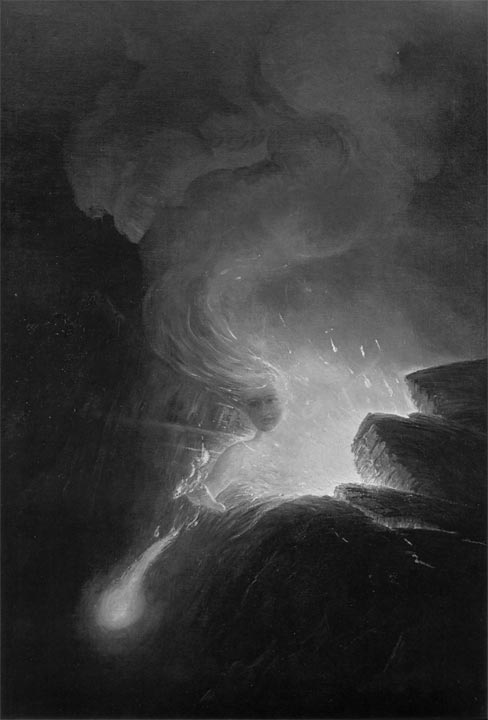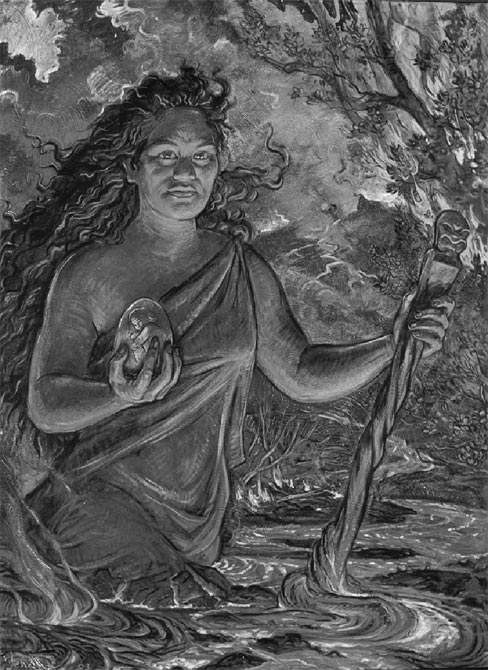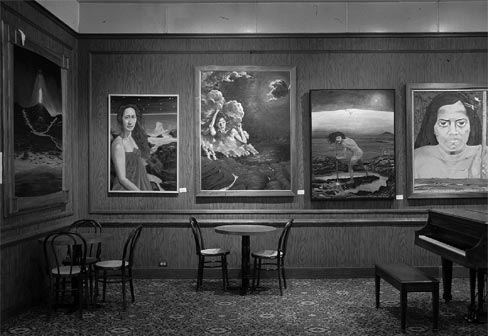Research Report
The "Visions of Pele" Competition and Exhibit at Hawai'i Volcanoes National Park
by Jeremy Spoon
In 2003, a member of the Hawai'i Volcanoes National Park's Kupuna Consultation Group of local Kanaka Maoli (Native Hawaiian) elders suggested that it was time to replace the 1927 painting of Pele, the goddess of the volcano, in the main visitor center with a more appropriate portrayal. The 1927 painting, by D. Howard Hitchcock, one of Hawai'i's most prolific artists, showed a westernized, European-featured Pele emerging from a volcanic eruption.(Figure 1) In the fall of that year, the park launched a blind competition for a new Pele portrait with the Sacred Mountains Program of The Mountain Institute (TMI) as a key partner for planning and fundraising. Juried by the Kupuna, the competition and accompanying exhibit, "Visions of Pele" made history as the first park interpretive project to be directed by Kanaka Maoli elders.(1)
 |
Figure 1. D. Howard Hitchcock's 1927 painting of Pele shows the volcano goddess with European facial features. (Courtesy of Hawai'i Volcanoes National Park.) |
Established by President Woodrow Wilson in 1916, Hawai'i Volcanoes National Park preserves and protects a complex ecosystem on the Big Island of Hawai'i representing 70 million years of volcanism, migration, and evolution. The park includes the sacred home of Pele at the summit of the Kilauea Caldera, the island's youngest volcano. According to Kanaka Maoli folklore, Pele came to the Hawaiian Islands from Tahiti in search of a home for her fire and her siblings. She stopped on every island, eventually settling in Halema'uma'u crater atop Kilauea.(2) Pele is recognized worldwide as a spiritual being, and she figures prominently in the place imagery of Hawai'i and the Kanaka Maoli.(3)
"Visions of Pele" Competition and Exhibition
The "Visions of Pele" art competition was open to all Hawaiians, both Native and non-Native. The winner received a cash prize and the distinction of having his or her work displayed in the park visitor center. The results far exceeded expectations, with more than 140 entries. The Kupuna selected 67 that best approximated their vision of what a portrayal of the goddess Pele should look like. The winning artist, European American Arthur Johnsen, had modeled his depiction of Pele after a Kanaka Maoli woman from the nearby town of Kalapana.(Figure 2)
 |
Figure 2. The Kapuna selected this painting of Pele by Arthur Johnsen for the Kilauea Visitors Center. (Courtesy of the Hawai'i Volcanoes National Park.) |
The park exhibited the top 67 paintings at three separate venues: the Volcano Art Center, an independent, nonprofit organization showcasing art of the Big Island of Hawai'i; the Jagger Museum, a natural science museum dedicated to the study of volcanism; and the Volcano House Hotel, a historic guesthouse built in 1941.(4)(Figure 3) With the blind competition complete, the park displayed the names of the artists along with the titles of the paintings. The top 67 included interpretations of Hawaiian folktales, non-anthropomorphic views, and depictions of Pele in various settings on the island of Hawai'i and elsewhere.
 |
Figure 3. A selection of 67 paintings from the "Visions of Pele" competition were exhibited at the Volcano House Hotel and two other venues. (Courtesy of Edwin Bernbaum.) |
Public Response and Impact
Visitors to the "Visions of Pele" exhibit had the option of completing survey forms and providing demographic information. When the exhibit closed, the author analyzed a sample of 185 surveys completed by visitors over the age of 18 as part of a graduate research project. He also used deductive coding to track themes and analyze newspaper articles related to the competition and exhibit published between May and September 2003.(5)
The survey results and media analysis suggest that many visitors, ranging from Hawai'i residents to international visitors, had a deeper respect for Native Hawaiian culture after seeing the exhibit. Because the exhibit presented a variety of contemporary visions of Pele, visitors were able to appreciate the Kanaka Maoli as a living culture connected to the lands within the park. This idea contrasts with the perception, gleaned from interpretive programs and exhibits using the past tense or emphasizing archeological excavations, of indigenous cultures as static. The survey results also revealed that Native Hawaiians who had visited the exhibit were satisfied overall with the outcome and encouraged by the park's efforts to work with Kanaka Maoli elders in representing Kanaka Maoli culture and heritage in an appropriate light.
The "Visions of Pele" project shows how parks and other protected areas can involve and empower local indigenous communities in decisions affecting how they and their culture are portrayed. In Hawai'i, the Kanaka Maoli are among the state's poorest and most disenfranchised populations. By involving and consulting community leaders, the park not only positively impacted the community but also strengthened the community's connection to the park. In the end, the "Visions of Pele" project demonstrated that among the best advisors on matters relating to the portrayal and the interpretation of cultural heritage are the heirs of that heritage themselves.
About the Author
Jeremy Spoon is a doctoral candidate in anthropology at the University of Hawai'i at Manoa working with the Khumbu Sherpa in Sagarmatha (Mount Everest) National Park, Nepal.
Notes
1. The "Visions of Pele" project was made possible through the collaborative effort of multiple parties including the park, The Mountain Institute's (TMI) Sacred Mountains Program (http:// www.mountain.org/sacredmountains/), the Hawai'i Tourism Authority, the County of Hawai'i Department of Research and Development, and the Volcano Art Center. The second phase of the project is to select a sculpture reflecting the sacredness of Mauna Loa and Kilauea Caldera. The author served the dual role of independent graduate student researcher and program officer for TMI's Sacred Mountains Program. The research project was funded by a National Science Foundation Graduate Research Fellowship with the help of the University of Hawai'i Department of Anthropology. For the full study see Jeremy Spoon, "Gazing at Pele: Native Hawaiian Cultural Representation at Hawai'i Volcanoes National Park" (2005), on file at the Hawai'i Volcanoes National Park Library and Archives.
2. The Kanaka Maoli still hold ceremonies and present offerings to Pele at Kilauea Caldera and Haleuma'uma'u crater. See Mary Kawena Puku'i, Caroline Curtis, and Don Robinson, Hawai'i Island Legends (Honolulu, HI: Kamehameha Schools Press, 1996); and Samuel Kamakau, Ka Po'e Kahiko: The People of Old (Honolulu, HI: Bishop Museum Press, 1968).
3. Haunani-Kay Trask, "Tourism and the Prostitution of Hawaiian Culture," Cultural Survival Quarterly 24, no.1 (2000): 21-23.
4. The exhibit ran from August 24 to October 1, 2003. A guesthouse has occupied the site of the Volcano House Hotel since 1846.
5. The results of the survey represent the views of those who completed the survey forms. They do not represent the views of all visitors or any specific group of visitors. On deductive coding see Russell Bernard and Gery W. Ryan, "Text Analysis: Qualitative and Quantitative Methods," in Handbook of Methods in Cultural Anthropology, ed. Russell Bernard (New York, NY: Altamira Press, 1998), 595-646.
